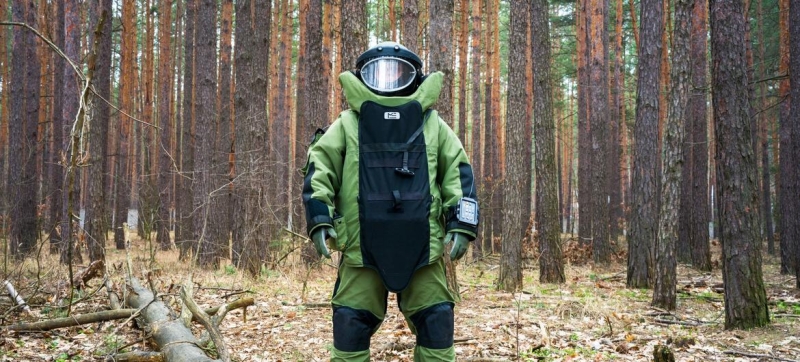
Explosive Ordnance Disposal Specialist, Ukraine. Hundreds of Thousands of Mines: Professionals and Volunteers Across Ukraine Join the Work to Clear Territories and Protect Populations Peace and Security
The war is not over yet, but it is never too early to start demining, according to the United Nations Development Programme (UNDP). Professionals and volunteers across Ukraine are joining this vital effort to clear the land of unexploded ordnance as quickly as possible. UNDP is supporting their efforts.
Nearly a quarter of Ukraine may be mined
Ukraine is currently the most heavily mined country in the world: around 23 percent of its territory may be “contaminated” by hundreds of thousands of landmines and unexploded ordnance. Clearing them could take decades and requires significant investment. In Ukraine’s case, demining costs are expected to be around $34.6 billion.
Mines pose a significant threat to civilians and significantly limit the country’s economic potential. Supporting demining activities in the early stages of recovery is key to helping people start a new life.
Shortage of specialists
The State Emergency Service of Ukraine relies on explosive ordnance disposal (EOD) teams, but there is a shortage of trained specialists across Ukraine. There are currently about 4,000 deminers in the country, but this is not enough.
“I think that even if we gathered all the sappers or trained people who know how to demining from all over the world and brought them to Ukraine, it still wouldn’t be enough,” says Deputy Minister of Economy of Ukraine Igor Bezkaravaynyi.
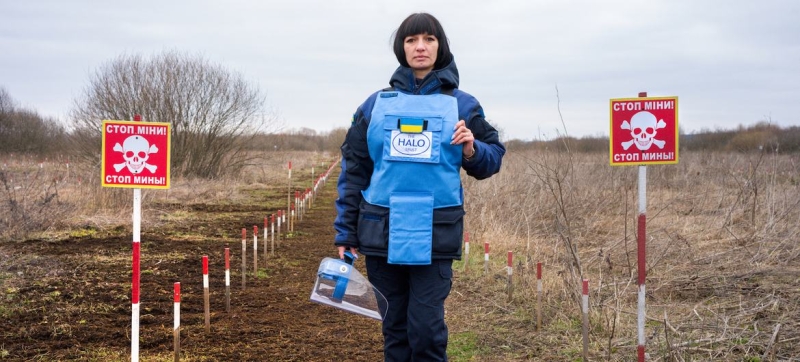
Alexandra Evdokimova is a volunteer involved in demining.
My children are my motivation
Volunteer Alexandra Evdokimova was a logistician with no previous experience before she began working in demining a year and a half ago.
“As far as I can see, the ratio of men and women (on the staff) is almost 50/50,” she says.
“My children are my motivation. They live in a country that is currently unsafe due to landmines. My goal is to make every inch of our land free of these threats,” Alexandra adds.
A demining dog trains children
Early in the war, Jack Russell terrier Patron and his handler, Mikhail Iliev, worked to defuse unexploded Russian bombs and mines near their hometown of Chernigov. When the State Emergency Service posted a video of Patron sniffing debris and sitting on Iliev’s lap while wearing a small flak jacket, it immediately went viral.
Patron continues to work with Iliev as a deminer, but he also plays an important role in educating children about mine dangers. Patron has his own YouTube channel, where he posts videos on what to do if he finds a mine or unexploded shell.
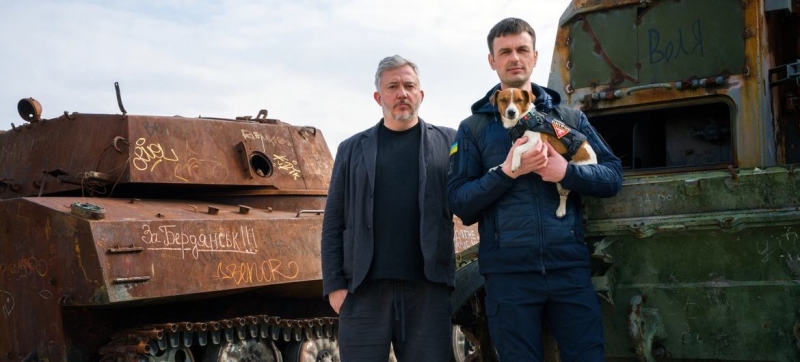
Patron the dog, trainer Mikhail and photographer Giles Duley.
The Role of the Media
Platforms such as YouTube and other media are an important tool for raising awareness of the dangers of mines among the population – not only for children, but for people of all ages.
As of August 2024, 1,286 civilians in Ukraine have fallen victim to mines and explosive ordnance as a result of the war. Many of those affected, like photographer Giles, have become advocates for mine action and awareness.
Elena Kozubovskaya is a journalist from the Nikolaev region, one of the most mined areas of Ukraine.
“Mine danger is my topic, and I often write articles about explosive devices, the rules for handling them, and the people who are involved in the mine problem in one way or another,” she says.
Many accidents are associated with careless handling of ammunition, and the media plays an important role in informing people about this danger. At the same time, journalists must take into account the emotional state of those who have become victims of mine incidents, Elena emphasizes.
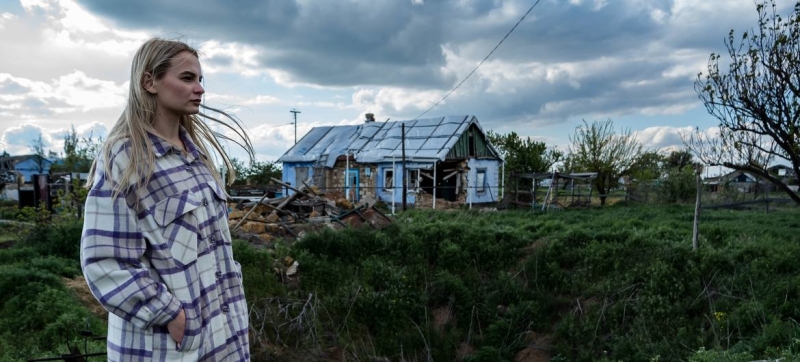
Journalist Elena Kozubovskaya.
“When I was writing an article about two brothers who lost their legs in a mine explosion, I had to carefully choose the right words so as not to cause additional pain,” she explains.
“I don’t want to hurt them even more [emotionally], but it’s important to me to tell their story because I believe it can save someone else’s life,” the journalist adds.
Kozubovskaya underwent special training as part of a joint project by UNDP, the State Emergency Service and BBC Media Action to inform the public about the mine threat and promote safe behavior.
A deminer who lost his leg vision
Vladislav Yeshchenko was working for a humanitarian organization clearing mines when the full-scale invasion began. He joined a Ukrainian military sapper unit serving on the front lines in the Donbas, working for nine months without a day off. He was blinded and partially deaf after stepping on a mine.
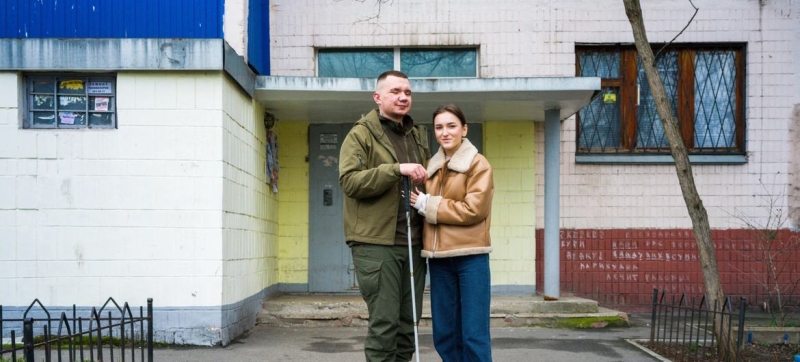
Vladislav Yeshchenko and his wife Valeria.
After spending four months in the hospital and undergoing long-term rehabilitation, Yeshchenko became a co-founder of the charity organization “We Will See Victory”, which helps people who lost their sight due to the war. His wife Valeria is responsible for managing the fund.
Military, para-athlete, deputy minister
Igor Bezkaravaynyi lost part of his leg in 2015 when his armored personnel carrier hit an anti-tank mine during fighting in the Donetsk region. Bezkaravaynyi subsequently became a para-athlete, served as deputy minister for veterans’ affairs, and was appointed deputy minister of economy in July 2023. In his work, he pays special attention to demining.
“When I worked at the Ministry of Veterans’ Affairs, we had data, and I remember that we had about 1,500 veterans with such injuries [amputations],” Bezkaravaynyi says.
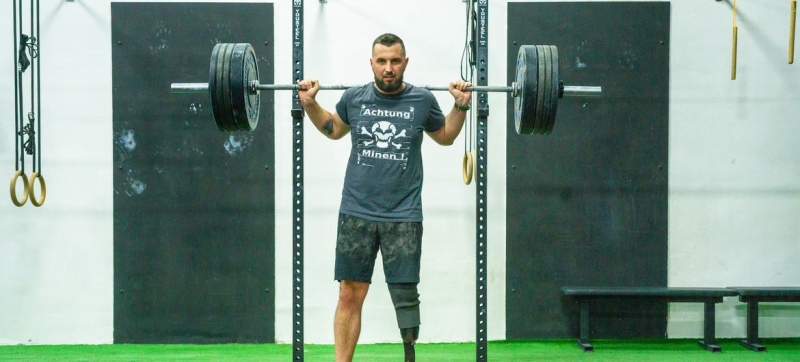
Igor Bezkaravayny.
“But now it’s thousands and thousands and thousands. It’s a completely different situation,” he adds.
Some veterans who suffered from explosive ordnance are now being trained to operate unmanned aerial vehicles. Four ‘graduates’ of the course have been offered jobs with the demining charity The HALO Trust.
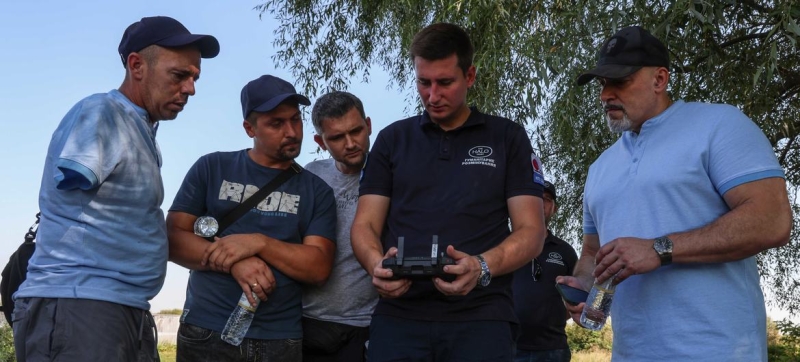
Veterans are trained to operate unmanned aerial vehicles.
Damage to Agriculture
Land contamination by mines has a negative impact on various sectors of the economy, especially agriculture. Ukraine is one of the ten largest wheat producers in the world. Its grain is imported by 57 countries. Before the war, almost 90 percent of wheat exports went to food-starved countries in Africa and Asia.
Sergey Tsvetkov’s farm in the Nikolaev region was occupied by Russian troops, and half of his land was mined. To this day, shells regularly fall on his territory.
“I had 3,500 hectares, but at the moment I would say I have half that I can use,” Tsvetkov says.
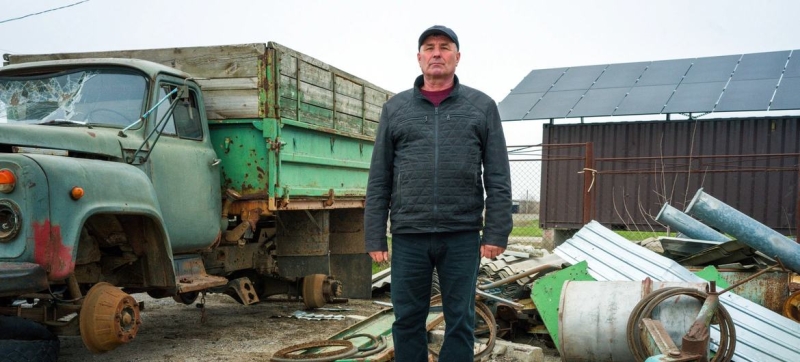
Half of the land owned by Sergei Tsvetkov is mined.
“I understand that it is very difficult to demin this land, and I understand that it takes time. So, of course, I worry about myself and my colleagues, especially when we start working on a recently demined field,” he adds.
Clearing the territories will allow Ukraine to start using its lands for agricultural purposes again.
“Ukraine is an agricultural country,” explains First Deputy Prime Minister and Minister of Economy Yulia Svyrydenko. “And we must understand how we can improve procedures, technologies and rules in order to return this land to productive use as quickly as possible.”
Modern technologies speed up the demining process
Using the latest technology and innovation will help speed up the demining process. UNDP has provided the State Emergency Service with computers, personnel, personal protective equipment, vehicles and equipment to support mine clearance, including using satellite imagery and artificial intelligence.
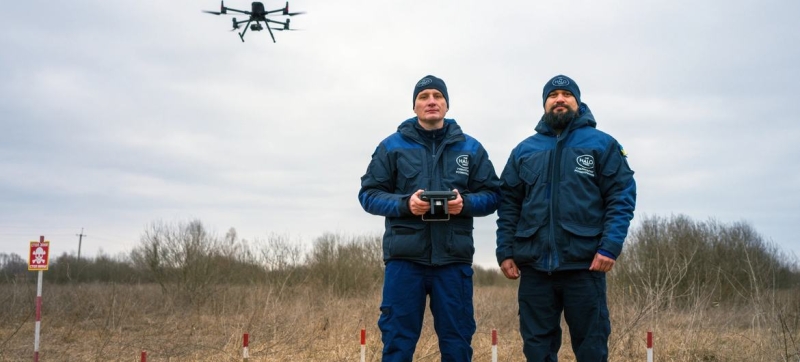
Drones are used to survey minefields and search for explosive devices.
The HALO Trust uses drones to survey minefields and search for explosive devices. This speeds up the demining process and reduces the risks to deminers.
Dogs are more effective than metal detectors
UNDP is constantly testing new innovative methods that do not always involve technology. One of the new initiatives is the use of specially trained sniffer dogs that can search an area of up to 1,500 square meters a day, compared to the 20-50 square meters a day that a human can cover.
The dogs ignore scrap metal and only detect the smell of explosives. Under certain conditions, they find mines much faster than metal detectors.
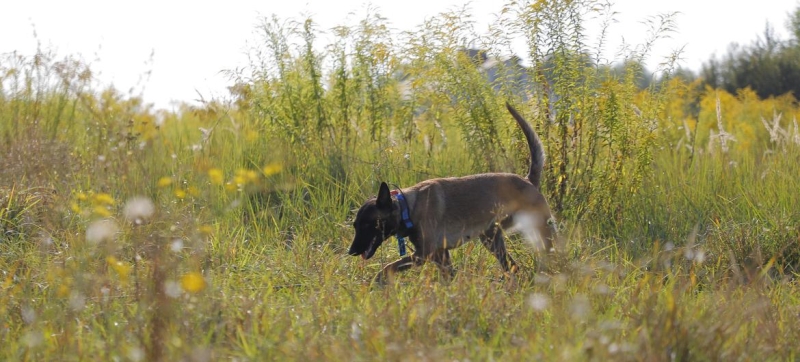
Dogs can explore an area of up to 1,500 square meters per day.
35,000 square kilometers already cleared of mines
Over the past 2.5 years, Ukraine has surveyed 35,000 square kilometers of its territory, declaring it free of mines, and started developing new demining technologies. Complete demining remains a complex and time-consuming task.
UNDP supports the Ministry of Economy in achieving its goal of minimizing the impact of landmines within ten years. The work still requires significant investment and new demining methods for safer and faster recovery of Ukrainian territories.
*The article is based on UNDP materials. Most of the photographs are provided by Giles Duley, who has been documenting the problem of landmine contamination in Ukraine since 2015. Duley lost both legs and his left arm in an improvised explosive device explosion in Afghanistan in 2011. In 2022, the UN appointed him as the first Global Advocate for People with Disabilities in Conflict.
